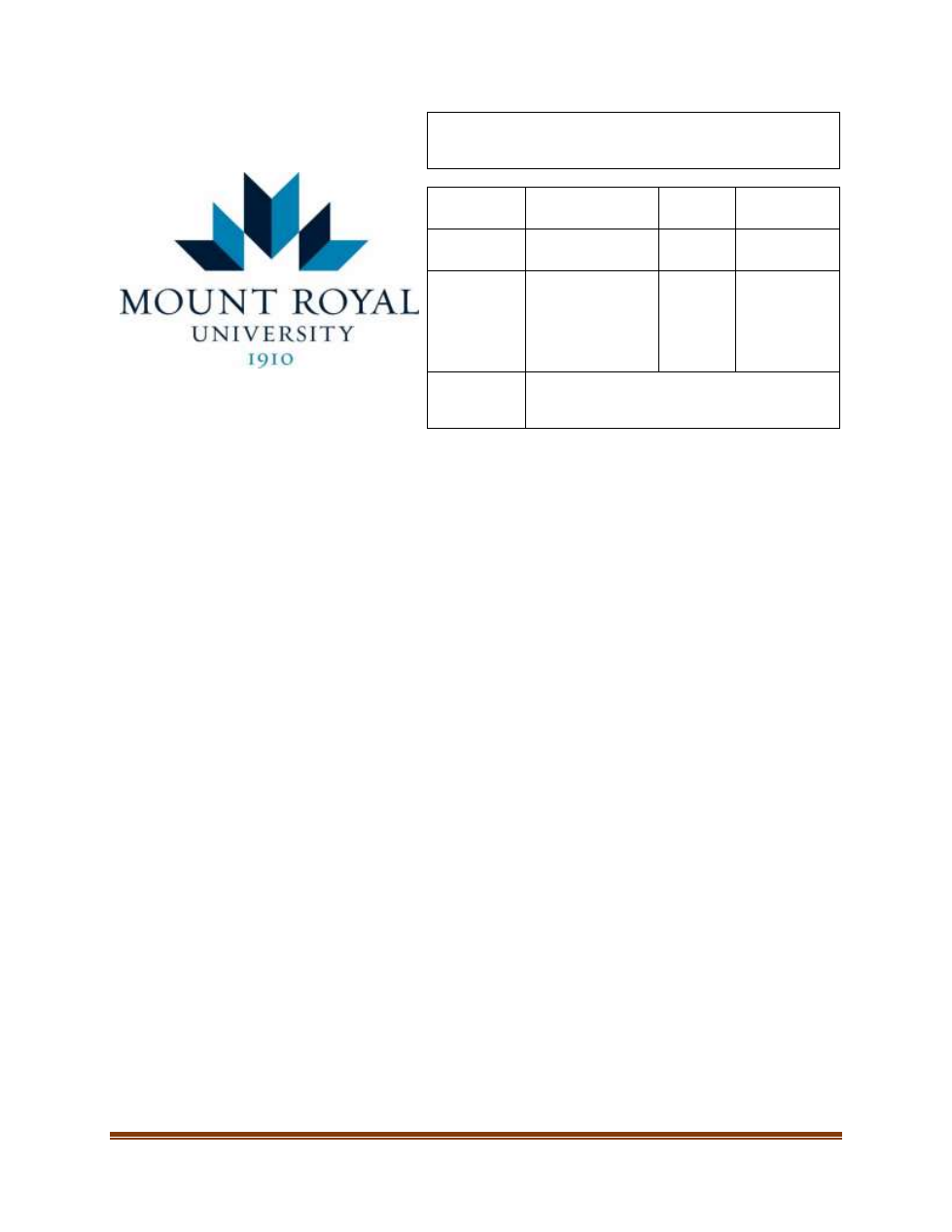
Biosafety Program
– April 4, 2011
Page 1 of 10
BIOSAFETY PROGRAM
Procedure
Type:
Management
Initially
Approved:
April 4, 2011
Procedure
Sponsor:
Provost and Vice-
President, Academic
Last
Revised:
April 2011
Administrative
Responsibility:
AVP, Research,
Scholarship and
Community
Engagement; and,
Office of
Occupational Health
and Safety
Review
Scheduled:
April 2024
Approver:
Executive Leadership Team
A.
PROCEDURES
1.
PURPOSE OF BIOSAFETY PROGRAM
1.1
To protect employees, students, the community, and the environment from risks
which may arise in the handling of potentially hazardous biological materials by
ensuring that the elements of the biosafety program are implemented prior to work
being conducted with potentially hazardous biological material:
a.
1 Supervisor planning to work with Biohazardous Material shall file a
biohazard application with the Biosafety Committee;
b.
approval shall be obtained from the Biosafety Committee prior to work
commencing;
c.
containment facilities must be approved by the Biosafety Officer;
d.
the level of training of the persons assigned to the project must be
approved by the Biosafety Committee.
1.2
To ensure compliance with the Occupational Health and Safety Act (Code) and
Regulations, the Canadian Food Inspection Agency, the Environmental Protection
Act and the guidelines of Health Canada, the Natural Sciences and Engineering
Research Council (NSERC), and all applicable federal and provincial regulations
respecting Biohazardous Material management.
2.
SCOPE
2.1
All teaching and research projects which use:
a.
Infectious biological agents;
b.
Potentially Oncogenic Biological Materials;
c.
Recombinant DNA which may be hazardous to humans, animals, or other
life forms;

Biosafety Program
– April 4, 2011
Page 2 of 10
d.
Human and simian cell cultures and bodily fluids;
e.
Transgenic material which may be hazardous to humans, animals, plants,
and the environment; or,
f.
Parasites.
2.2
All persons who work with or arrange for transportation of Biohazardous Material
must be trained as per the Transportation of Dangerous Goods Act and any other
applicable federal or provincial regulations regarding Biohazardous Material.
3.
PROGRAM
3.1
Authority
The Biosafety Committee has the authority, on behalf of the Associate Vice-
President, Research, Scholarship and Community Engagement to stop
immediately any use of Biohazardous Material which deviates from the approval
outlined in the Biosafety Certificate or is deemed to be in non-compliance with the
applicable standards.
3.2
Responsibility
a.
The day-to-day requirement to comply with safe use of Biohazardous
Materials in research and teaching under the auspices of Mount Royal
University is the responsibility of the Principal Investigator or course
instructor.
b.
All lab workers using Biohazardous Materials in research or teaching must
have the necessary expertise and appropriate training in accordance with
the policies of Mount Royal University. The Biosafety Officer, in
consultation with the Biosafety Committee, will decide upon the
appropriate methods of achieving the appropriate expertise and training
levels.
c.
The acquisition of all Biohazardous Materials (by purchase, culture or
transfer from another source) must be arranged in accordance with
protocols approved by the Biosafety Committee.
d.
The disposal of all Biohazardous Materials must be in accordance with
protocols approved by the Biosafety Committee and in compliance with all
relevant federal, provincial, and government regulations and guidelines.
e.
The Biosafety Officer, in close collaboration with the Biosafety Committee,
is responsible for monitoring the compliance of researchers and instructors
with the Biosafety Policy and the terms of approval of their projects.
i.
If the Biosafety Officer observes or becomes aware that relevant
regulations or guidelines are not being followed in any teaching
program or research study, she/he will advise the Principal
Investigator or instructor so that prompt remedial action can be
taken.

Biosafety Program
– April 4, 2011
Page 3 of 10
ii.
In the event that this is not done to her/his satisfaction, the
Biosafety Officer will alert and consult with the Biosafety
Committee.
iii.
In circumstances where the Biosafety Officer is of the opinion that
the situation presents immediate significant risk, the Biosafety
Officer may take whatever action he/she considers necessary to
remedy the situation.
iv.
The Biosafety Officer keeps the Biosafety Committee and the
Associate Vice-President, Research, Scholarship and Community
Engagement fully informed of such incidents and the reason for
the action taken.
v.
He/she may also, at her/his discretion, seek the advice of experts
as may be appropriate.
f.
The Biosafety Officer maintains up-to-date records of all biosafety
certifications, approved locations, certified users, containment equipment,
equipment certifications, and personnel training.
g.
The Biosafety Officer reports to the Biosafety Committee with a summary
of such records.
h.
The Biosafety Officer ensures that researchers use appropriate
containment facilities by the proposed research involving Biohazardous
Materials.
i.
All proposals involving the use of Biohazardous Materials in research and
teaching require the prior approval of the Biosafety Committee. The
detailed responsibilities and powers of the Biosafety Committee are those
set out in the Terms of Reference.
3.3
Standard Operating Procedures
Standard Operating Procedures and other guidelines for project approval,
inspections, acquisition, use, storage, and disposal of Biohazardous Materials are
developed and published, in conjunction with the Biosafety Officer, by the Principal
Investigator after having been approved by the Biosafety Committee.
4.
CONSIDERATION OF APPLICATION TO USE BIOHAZARDOUS MATERIALS
4.1
Application of the Terms of Reference of the Use of Biohazardous
Materials in Research and Teaching
a.
Research and teaching involving Biohazardous Material must be carried
out in accordance with the applicable laws such as the Occupational
Health and Safety Act, the Laboratory Biosafety Guidelines from the Public
Health Agency of Canada, and Tri-Council Memorandum of
Understanding requirements.
b.
All research, teaching, or training activities using Biohazardous Material
shall be approved by the Biosafety Committee before use can commence.
Any modification to the original and approved protocol shall be submitted
for approval prior to making these modifications to an experiment.

Biosafety Program
– April 4, 2011
Page 4 of 10
4.2
Steps Taken by the Principal Investigator or Instructor
a.
Review and understand the University's Biosafety Policy.
b.
Ensure that:
i.
the physical laboratory environment meets the standards required
for the Biohazard Level applied;
ii.
a laboratory procedures manual is available in the lab. The
manual needs to meet at least the standards outlined in the "MRU
Laboratory Safety Handbook;"
iii.
all personnel working in the laboratory have been trained. The
training needs to be recorded in writing.
c.
It is recommended that the application be reviewed by the Biosafety
Officer prior to submission to the Biosafety Committee. The application
form is available from the Biosafety Officer or from the Research website.
The application must be submitted to the Biosafety Officer at least two
weeks before the planned commencement of the project, consisting of
hard and electronic copies of the following:
i.
Application form;
ii.
Biohazard containment certificate (teaching facility or research
project);
iii.
A laboratory specific procedure manual for the project/course or
standard operating procedures for the research activity;
iv.
Training record;
v.
Health Canada application for permit to import human
pathogen(s), if required (the Biosafety Officer would make such
an application);
vi.
Canadian Food Inspection Agency Application for permit to import
animal pathogen(s), if required (the Biosafety Officer would make
such an application);
vii.
Ather attachments as necessary (Biological Safety Cabinet
certificates, risk assessments, etc.); and,
viii.
Risk Assessment Form.
d.
The Biosafety Committee will review the application. If all written
documents are in order, the Biosafety Committee will schedule a facility
inspection. Once all criteria are met, a Biosafety Permit will be issued.
Biosafety permits are granted for one (1) year and require annual review.
The certificate must be posted in a location listed on the certificate. Site
inspections are required every six (6) months.

Biosafety Program
– April 4, 2011
Page 5 of 10
4.3
Steps Taken by the Biosafety Committee
a.
The Chair of the Biosafety Committee informs the Principal Investigator or
instructor of the Biosafety Committee's decision in writing.
b.
If the project is approved, the Biosafety Permit information will be made
available to the Office of Research Services. The Occupational Health
and Safety Office retains signed copies of all approved applications and
permits.
c.
If the project is not approved, the applicant is asked for more information,
and may be required to submit a revised project proposal for review by
members of the Biosafety Committee.
d.
If these actions fail to lead to approval of the project, the Chair of the
Biosafety Committee will provide the applicant with a written statement of
reasons for non-approval of the project.
e.
The applicant may ask for a hearing before the Biosafety Committee to
appeal the decision. In the event the appeal is not successful, the
applicant may appeal to the Associate Vice-President, Research,
Scholarship and Community Engagement who may appoint an appeal
committee. The decision of that committee, if ratified by the Associate
Vice-President, Research, Scholarship, and Community Engagement
would be final. Health Canada may be called upon for information
purposes; however, appeals cannot be directed to Health Canada.
f
Due to the safety-related mandate of the Biosafety Committee, appeals
will only be considered where the applicant believes there was bias or that
the Biosafety Committee failed to comply with the procedural requirements
of the Biosafety Policy.
4.4
Annual Reports and Renewals
a.
The applicant must renew their research applications annually and, in the
case of teaching protocols, they must be renewed every semester. Any
changes to the application must be submitted as an amendment and
approved before implementation. Major changes may warrant submission
of new application.
b.
The Principal Investigator or instructor must notify the Biosafety
Committee of any changes in agent(s), procedure(s), or personnel using
the Biosafety Renewal/ Amendment Form.
c.
Update training for new personnel and ensure that the training records are
up to date.
4.5
Two Stage Approvals
a.
Where the research involving biohazards will not be undertaken
immediately, there can be a two stage approval process for multi-year and
multi-stage projects.
b.
An "in-principle" application must be submitted to the Biosafety Committee
outlining the anticipated time the use of biohazards will commence as well
as the amount of funding required before receiving approval from the

Biosafety Program
– April 4, 2011
Page 6 of 10
Biosafety Committee for work with biohazards. This application will be
reviewed by the Biosafety Committee.
c.
The Principal Investigator or instructor must notify the Biosafety
Committee of any changes in dates or circumstances.
d.
The Principal Investigator or instructor must submit a report of work
completed as well as an application to work with biohazards before any
more funding can be released for the project.
5.
BIOSAFETY PROGRAM INSPECTION PROTOCOL
5.1
Regulations
Regulations pertaining to biohazard safety include:
a.
those from Canadian Federal Agencies;
b.
those from agencies that provide funding;
c.
the Occupational Health and Safety Regulation (Alberta);
d.
transport regulations;
e.
University policies; and,
f.
codes of best practice.
5.2
Principal Investigator Inspection Responsibilities
a.
Completes the biosafety checklist each month and posts a copy. Although
the Principal Investigator/instructor may delegate responsibilities, the
Principal Investigator/instructor remains accountable for all activities in
her/his laboratory and common rooms.
b.
Reports significant problems, illnesses suspected of originating from
biohazard work, incidents, or instances of non-compliance/ non-
conformance.
c.
The
Principal
Investigator/instructor
may
delegate
inspection
responsibilities to other lab personnel.
d.
The Biosafety Officer is available for consultation and guidance.
5.3
Biosafety Committee Responsibilities
a.
The Biosafety Committee (hereafter referred to as the committee) will
investigate and report on incidents relating to biosafety brought to its
attention whenever it is believed or suspected that any breach of
compliance or conformance or other safety hazard may have occurred or
is occurring.
b.
Committee members who are trained in biosafety to the satisfaction of the
committee may enter any containment level laboratory or its related
premises under the jurisdiction of Mount Royal University, at any time, to

Biosafety Program
– April 4, 2011
Page 7 of 10
examine items related to biosafety operational procedures or Physical
Containment.
c.
The committee may decide to not grant a Biosafety Permit where previous
indications of non-compliance/non-conformance indicate an unacceptable
risk.
d.
The committee is responsible for conducting and/or delegating
inspections.
e.
Inspections will be regularly conducted and of such frequency so as to
provide an assurance to the University that all labs are reasonably
believed to be in compliance and conformance at least once every year.
5.4
Biosafety Officer Responsibilities
a.
Promote and monitor compliance with policies, regulations and
procedures for safe use, handling, monitoring, storage, transport, and
disposal of Biohazardous Materials.
b.
Act immediately to address safety concerns, but also advise the Associate
Vice-President, Research, Scholarship and Community Engagement and
the committee on matters related to non-compliance/non-conformance.
c.
Be available for consultation on problems.
d.
Ensure proper maintenance of records.
e.
Investigate reports of biosafety non-compliance/non-conformance with the
committee.
5.5
First Formal Inspection
a.
Inspections will identify items requiring attention and a written list of these
items will be made available to the Principal Investigator/instructor.
b.
Items that were rectified during the inspection will be noted.
c.
Items that cannot be rectified immediately will necessitate a second
inspection.
5.6
Second Formal Inspection
a.
A second formal inspection will be conducted to determine whether the
items requiring rectifying were addressed in a timely fashion. A summary
of the inspection results will be made available to the Principal
Investigator/instructor and to the committee. The committee, upon
reviewing the second inspection results, may:
i.
file a report with the Biosafety Officer and notify the Principal
Investigator/instructor that the laboratory or area is in
compliance/conformance; or
ii.
issue a notice to the Principal Investigator/instructor requesting a
written response to indicate either:

Biosafety Program
– April 4, 2011
Page 8 of 10
• how compliance/conformance will be attained; and/or,
• why the Principal Investigator/instructor believes the
laboratory and personnel are in full compliance/ conformance.
5.7
Review of Written Response
If the Committee has requested a written response, the Committee will review that
response and:
a.
If the Committee concurs that the laboratory or area is in compliance/
conformance,
the
committee
will
so
notify
the
Principal
Investigator/instructor and Occupational Health and Safety;
b.
If the Committee believes that the written proposed actions will suitably
address the non-compliance/non-conformance, the Committee will so
notify the Principal Investigator/instructor and schedule a third inspection
for verification; or,
c.
If the Committee believes the laboratory or its personnel will remain in a
state of non-compliance/non-conformance, the Committee will engage in
communication with the Principal Investigator/instructor until such time as
the Committee deems that a third inspection or alternate action (such as
permit suspension) is appropriate. If the permit is suspended, the
committee will notify the Associate Vice-President, Research, Scholarship
and Community Engagement and the granting agencies.
5.8
Third Formal Inspection
a.
A third formal inspection will be conducted under the condition noted
above. A summary of results will be made available to the Principal
Investigator/instructor and to the Committee. The Committee upon
reviewing the third inspection results may:
i.
File a report with the Biosafety Officer and notify the Principal
Investigator/instructor that the laboratory or area is in
compliance/conformance, or,
ii.
If the Committee believes that the laboratory or its personnel will
remain in a state of non-compliance/non-conformance, the
Committee will engage in communication with the Principal
Investigator/instructor until such time as the committee deems that
alternate action is appropriate.
5.9
Consultation Outcome
a.
File a report with the Biosafety Officer and notify the Principal
Investigator/instructor
that
the
laboratory
or
area
is
in
compliance/conformance; or,
b.
Notify the Associate Vice-President, Research, Scholarship and
Community Engagement and the Principal Investigator/instructor, and
granting agencies that the permit is suspended.

Biosafety Program
– April 4, 2011
Page 9 of 10
5.10
Immediate Dangers
If an immediate danger to people or the environment is observed, the Biosafety
Officer or the Committee may immediately suspend the Biosafety Permit for that
work and require the cessation of that work. The Committee will notify the
Associate Vice-President, Research, Scholarship and Community Engagement of
the suspension.
5.11
Appeals
Decisions of the Committee may be appealed to the Associate Vice-President,
Research, Scholarship and Community Engagement using the appeals process
specified in the Office of Research Services Procedures Manual.
B.
DEFINITIONS
(1)
Biohazardous
Material:
Bacteria, viruses, parasites, fungi, and other infectious
agents which are pathogenic to humans for animals. In
addition, Recombinant DNA or genetic manipulations which
may present a risk and all mammalian cell in culture until
proven to be free of adventitious agents
(2)
Biological Restricted
Area:
A Physical Containment classification based on level of risk
or hazard to be encountered while handling Biohazardous
Material. There are four levels of Physical Containment
based on the Health Canada Guidelines
(3)
Oncogenic
Biological Material:
A material that induces cancer such as a malignant tumour.
Oncogenic viruses are a typical example of this material
(4)
Policy:
means the Biosafety Policy
(5)
Physical
Containment:
Use of physical facilities and equipment and good work
practices to prevent the release of organisms into the
environment
(6)
Principal
Investigator:
A faculty or supervisory staff member who is responsible for
the research project
(7)
Recombinant DNA:
a. DNA molecules which are constructed outside the living
cells by joining natural or synthetic DNA molecules that can
replicate in a living cell; or,
b. DNA molecules that result from the replication of those
described in a
(8)
Risk Group:
The Health Canada system of classification of infective
pathogens by severity of individual or community risk. Risk
Group 1 presents the least level of risk and Risk Group 4
presents the most risk
(9)
University:
means Mount Royal University

Biosafety Program
– April 4, 2011
Page 10 of 10
C.
RELATED POLICIES
• Biosafety Policy
D.
RELATED LEGISLATION
• Alberta Occupational Health and Safety Act
• Canada Environmental Protection Act
• Canada Transportation of Dangerous Goods Act
E.
RELATED DOCUMENTS
• Biosafety Management Procedures
• Biosafety Committee Terms of Reference
• Health Canada Laboratory Biosafety Guidelines, 3
rd
Edition, 2004
• Natural Sciences and Engineering Research Council of Canada (NSERC) Guidelines
• Office of Research Services Procedures Manual
F.
REVISION HISTORY
Date
(mm,dd,yyyy)
Description of
Change
Sections
Author
(Position Title)
Approver
(Position Title)
04/04/2011
NEW
12/09/2022
Editorial
Job Titles
Policy Advisor
University Secretary









